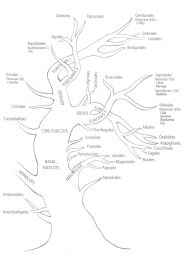The 'wild' cocoas



Overview
As written above in Chapter 3: The Rediscoveries, Theacrine was detected in the seeds of Cupuaçu (Theobroma grandiflorum) by Brazilian researchers in 19752. Thereupon, by isotope dilution we found a concentration of 0.25 %3. For this purpose, we had to synthesize radioactive theacrine4 allowing its accurate determination in a challenging matrix. Not only the seeds of Cupuaçu but also those of the common cocoa are rich in fat what makes analyses of purine alkaloids difficult.
It took almost another 20 years till researchers of M&M/Mars showed that all Theobroma and Herrania species analyzed accumulate in the seeds almost exclusively theacrine. The only exception is T. cacao!5 (Though this chemotaxonomic distinction argues for the original grouping by Henri Pittier (1857-1950) in 1930 considering Herrania as a section of Theobroma6, we have to be cautious because the PuAs' role as taxonomic markers is not yet clear.) The theacrine values in the above-cited publication range from 0.02 - 0.35 % for Theobroma and from 0.23 - 2 % for Herrania.
Are there commercial cocoas with theacrine?
Cacao de ardilla
To my knowledge Herrania–derived products are not available over the counter or on the internet. However, it would a challenge to bring (after cultivation in a plantation) the 'high theacrine species' H. purpurea (Pittier) R.E. Schult. (see Fig. xy) to market! It grows in the lower forests on the Atlantic slopes of Costa Rica as a 3 to 4 m high tree with an unbranched trunk decorated with spectacular, long-ligulate red flowers and pubescent fruits, yellow when ripe (see Fig. xy, at 6 o'clock). The latter contain seeds of maize kernel size covered by a sweet and sour pulp. The Bribri Indians make a bitter chocolate drink from the roasted seeds1.
Theobroma grandiflorum
A much smaller theacrine concentration (0.25 %) have the seeds of Theobroma grandiflorum (Willd. ex Spreng.) K. Schum. indigeneous to Acre, Amazon, and Para. It is now kept in plantations and became a highly estimated cocoa in Brazil and Colombia, where it is called cupuaçu and copoazú, respectively. The large fruit which develops within 4 months has an outer woody wall coated with a velvet-like brown layer. When sawn in half we see a pudding-like structure, which is not a blancmange. If we again cut the 'pudding', we can recognize the cocoa seeds surrounded by a copious pulp with a pleasant aroma characterized by a profile of free and glycosidically or otherwise bound volatiles. It is used for all kinds of delicacies such as ice cream, juices, pralines, creams and tarts. Due to its fiber content its improves the texture of goat milk yogurts and cereal bars. A few patents focus on its use in cosmetics, but there are plenty which praise the seed butter as an ingredient of skin and hair care products1.
Finally, the longitudinal section reveals that the flattened seed of cupaçu essentially consists of the densely folded cotyledons, which unfold during germination and transform the lipids into energy.
Much work has been done by Brazilian and Columbian researchers on cultivation, genetics, processing and chemical analysis. Instead of manufacturing the seeds into the so-called cupulate (cupuaçu and chocolate), only the pulp was, as ever, locally used (see below), and the seeds were considered as waste and exported mainly to Japan, where a company trademarked 'cupuaçu' and filed a patent for producing cupulate! After a long debate, the Japanese application was declined due to the fact, that EMBRAPA, the Brazilian governmental agricultural research agency, had applied for a patent in the early nineteenninties.
Much studies aim at characterizing the potential of T. grandiflorum in agroforestry systems and may contribute to a firm basis for a sustainable production of a commodity of economic importance. A return to the agricultural values is indispensable for countries affected by recession.
But there may be a chance to get manufactured items prepared from theacrine containing seeds of T. grandiflorum or T. bicolor.
The 'Caffeines'
The
Caffeine Plants


